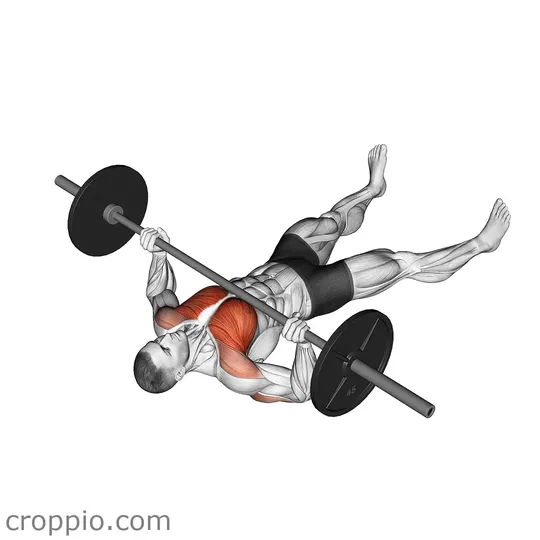Barbell Floor Press

Muscles Involved
The barbell floor press primarily targets the chest muscles, specifically the pectoralis major and pectoralis minor. This exercise also effectively engages the triceps brachii, making them the secondary muscle group targeted. Additionally, the anterior deltoids and the stabilizing muscles of the upper back, including the trapezius and rhomboids, are worked as you stabilize the barbell throughout the movement. By generally eliminating the leg drive used in a traditional bench press, the floor press emphasizes upper body strength and stability.
Top Mistakes
- Improper Wrist Position: Allowing the wrists to bend backward can create unnecessary strain. Keep your wrists straight and aligned with the forearms.
- Arching the Back: Lifting your lower back off the ground can compromise stability. Ensure your back remains flat against the floor.
- Inadequate Range of Motion: Not lowering the barbell all the way to the floor limits muscle engagement. Aim for a controlled descent until your upper arms touch the ground.
- Using Too Much Weight: Attempting to lift excessive weight can lead to poor form and increase injury risk. Start with a manageable load to master the technique first.
Execution Tips
- Set Up Properly: Lie on your back with your knees bent and feet flat on the floor. Position the barbell above your eyes on the floor.
- Grip Selection: Use a grip that is slightly wider than shoulder-width. This setup enhances stability and control.
- Engage Your Core: Maintain a tight core to support your back and promote proper alignment throughout the movement.
- Focus on a Controlled Motion: Lower the barbell slowly and pause briefly when it touches the floor before pressing it back up powerfully.
Workouts
To incorporate the barbell floor press into your workout routine, aim for 3 to 4 sets of 6 to 10 repetitions, depending on your training goals. You can integrate it as a primary lift in your upper body workout or as a complementary exercise following a bench press. Pair it with exercises targeting complementary muscles, such as the shoulder press, dumbbell flys, or tricep dips, to create a balanced upper body regimen.
Conclusion
The barbell floor press is an excellent exercise for boosting upper body strength, focusing particularly on the chest and triceps while minimizing shoulder strain. By eliminating the leg drive typically used in bench pressing, it forces the upper body muscles to work harder and improves stability and control throughout the pressing movement. Whether you're looking to enhance your bench press performance or build general upper body strength, the floor press is a valuable addition to your training arsenal.



